Lex Luger's Failed WWE Mega Push - Where Did It All Go Wrong?
Why did Lex Luger's WWE mega push fail?
WWE have gone to great lengths to create and install certified "faces of the company", especially in the years after Hulkamania began fading. Sometimes that process proved easy, like when Steve Austin and The Rock each hit upon million-dollar catchphrases and were given enough slack to properly cultivate their legends. Other times, it has been like pulling teeth - John Cena and Roman Reigns were each hand-selected to be the stars of their generations, though many fans vocally resisted their way-too-put-on babyface pushes.
One of the earliest attempts at creating a "new Hogan" was Diesel, as the then-WWF stripped away all of Kevin Nash's effortless charm and turned him into a smiling robot.
WWE went to highly unusual lengths to create their "new Hogan” before Diesel, though, going far beyond innocuous missteps like forcing a badass to play a smiling babyface, or having that new hero recite corny dialogue. In 1993, Vince McMahon was hellbent on assembling a new Hulkster in record time and his plan to achieve that involved a very big bus.

In 1993, WWE fans were living through the second wave of Hulkamania. Unfortunately for a hopeful Vince McMahon, this wave won't be as long or as strong as the original.
Hogan took a sabbatical following WrestleMania 8 in 1992, at a time when WWE was besieged with scandal. Hulk himself was plenty tainted, as in a disastrous interview on Arsenio Hall the previous year the reigning WWE Champion lied about his steroid use, trying to downplay it as minimal and only for rehabilitative purposes. Negative headlines followed, and business began to dip. At the same time Hogan took to leaning out his hallmark musculature, his fanbase began shrinking in lockstep.
So, in April 1992, Hogan went away. For the first time since 1984, WWE weren’t going to have Hogan front and centre, or even on standby. Under the weight of scandal and declining interest, WWE’s metrics took a major nosedive in 1992, at least domestically. Stars like Randy Savage and The Ultimate Warrior (who now wore shirts or singlets as ring attire to dress up their streamlined frames) couldn't stop the bleeding, as attendances and interest continued to drop.
A decision was made to go with smaller, more technically sound wrestlers on top for a while. Bret Hart and Shawn Michaels may not have been steroid-free throughout their careers, but they looked human enough and for that they were booked to win singles gold in late 1992, signalling the dawn of a new age.
Vince wasn't completely ready to move on without Hulk, however. In early 1993, Hogan found his way back to New York, returning in time to take part in a tag team match at WrestleMania 9.
Of course, Hogan did more than just work that tag match - he emerged from WrestleMania 9 as WWE Champion for the fifth time, as part of a convoluted ending wherein Bret lost the belt to Yokozuna, then Yoko immediately dropped the title to Hulk in an impromptu match.
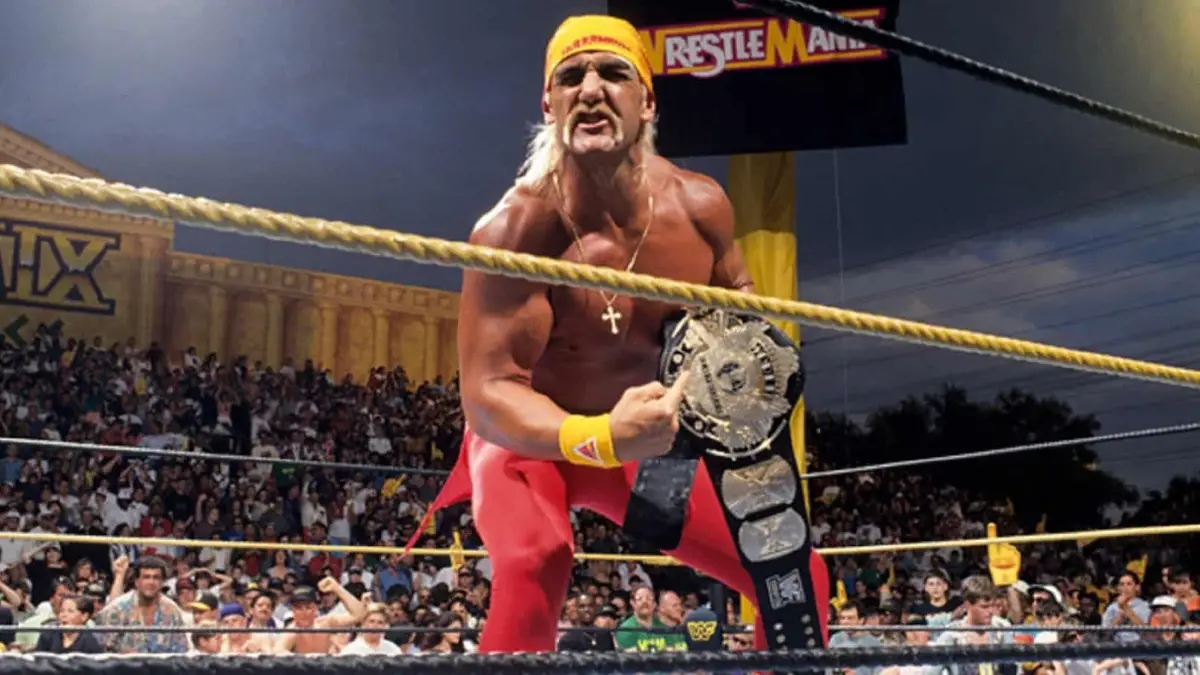
Instead of ushering in a reprisal of unfettered, 80s-style Hulkamania, what followed were several confusing months where Hogan never wrestled on TV and rarely appeared on camera outside of the occasional drop-in promo. He only worked house shows, as well as one date for New Japan Pro-Wrestling where he infamously denigrated the WWE Title belt to the media afterward, comparing it to "a trinket on a Christmas tree."
Most American fans wouldn't see that promo until the age of YouTube, but these were nonetheless strange times for WWE and Hulk Hogan. He lost the belt back to Yokozuna at King of the Ring that June, before playing out the string on the house show circuit. It wasn't exactly clear what Hulk's fifth reign was meant to accomplish.
What was clear was that WWE needed a new hero and it wasn't going to be Bret Hart. For all of his reliability, earnestness, and world-class technical skill, Hart just didn't tick all the boxes on Vince's checklist. Instead, "The Hitman" was merely the guy Vince turned to when things looked bleak, when a steady hand was needed to take the wheel.
What McMahon coveted was someone closer to the Hogan mould: a musclebound, impressive-looking heavyweight that could size up to any and all monster villains that might cross their path. Bret could blind those monsters with science, but Vince seemed to prefer the unambiguous "beat 'em up" method.
Fortunately for Vince, he appeared to have a capable suitor on his roster. In early 1992, Lex Luger departed WCW, after dropping the world title to rival Sting. In Luger's near five-year run with the Crockett-then-Turner-owned group, he'd enjoyed a sustained push at or near the top of the card, holding world, United States, and tag gold, and for a time was one of the Four Horsemen.
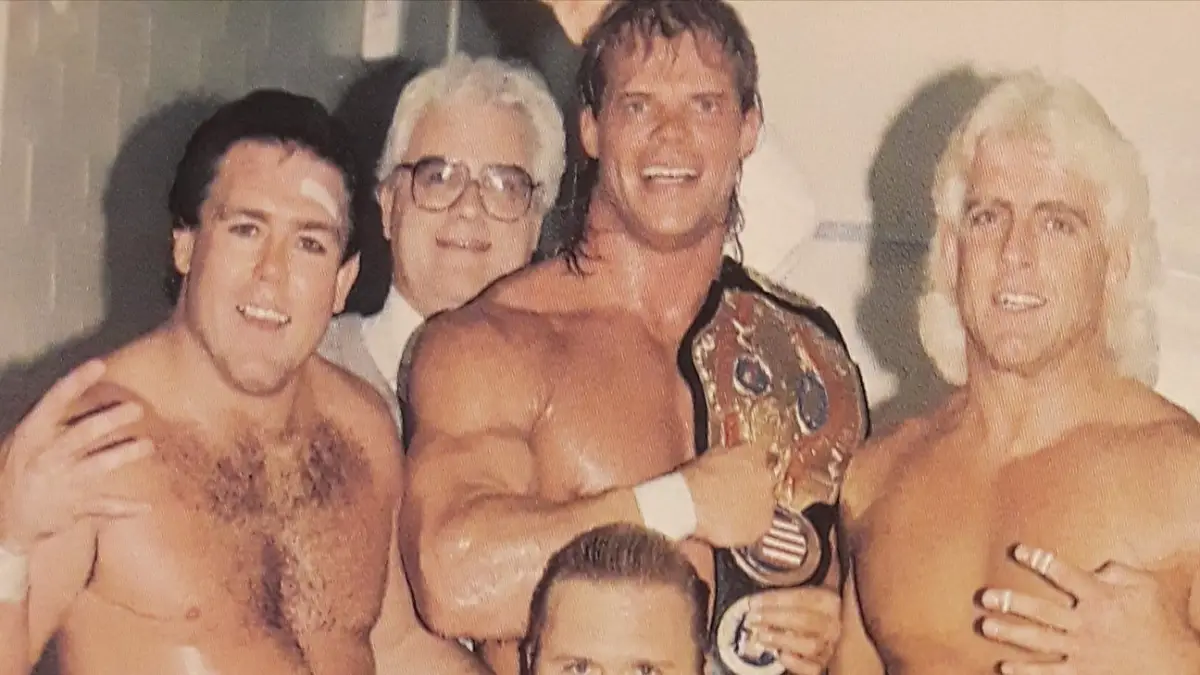
In the increasingly muscular 1980s, Luger had the ideal star look: a granite-carved physique with muscles in places most people don't even have places. Standing 6’ 5” tall, while sporting long blonde hair and the laid-back demeanour of a confident jock, Luger's nickname of "The Total Package" was apt. Even back then, some were forecasting Lex to be the second coming of Hulk.
Luger began his path to WWE shortly after winning the WCW World Heavyweight Title in 1991, in the fallout of prior champion Ric Flair's firing. The new champ was put off by the increasing turmoil in WCW's front office, and made the conscious decision to get out of the company as soon as possible.
To gain his release from WCW, Luger had to agree to a one-year non-compete in wrestling. To kill time before he could wrestle again, Luger and WWE made a curious arrangement: Lex would spend a year in Vince's World Bodybuilding Federation, then cross over into WWE in 1993.
The first part didn't exactly go to plan: Luger was badly injured in a June 1992 motorcycle accident, and was unable to appear for the WBF, which folded shortly after anyway. Luger got healthy just in time to make his WWE debut in early 1993 as "The Narcissist", a self-adulating mesomorph who admired his reflection in a full-length mirror prior to his matches.
Despite being a sizeable acquisition at a time when WWE was haemorrhaging big names, Luger didn't exactly make a huge impact on arrival. Though he was quickly put to work with Bret and Mr. Perfect, Luger felt like little more than a face in the crowd. "The Narcissist" just didn't stand out like "The Total Package" had, even if his (now reportedly drug-free) physique remained impressive.
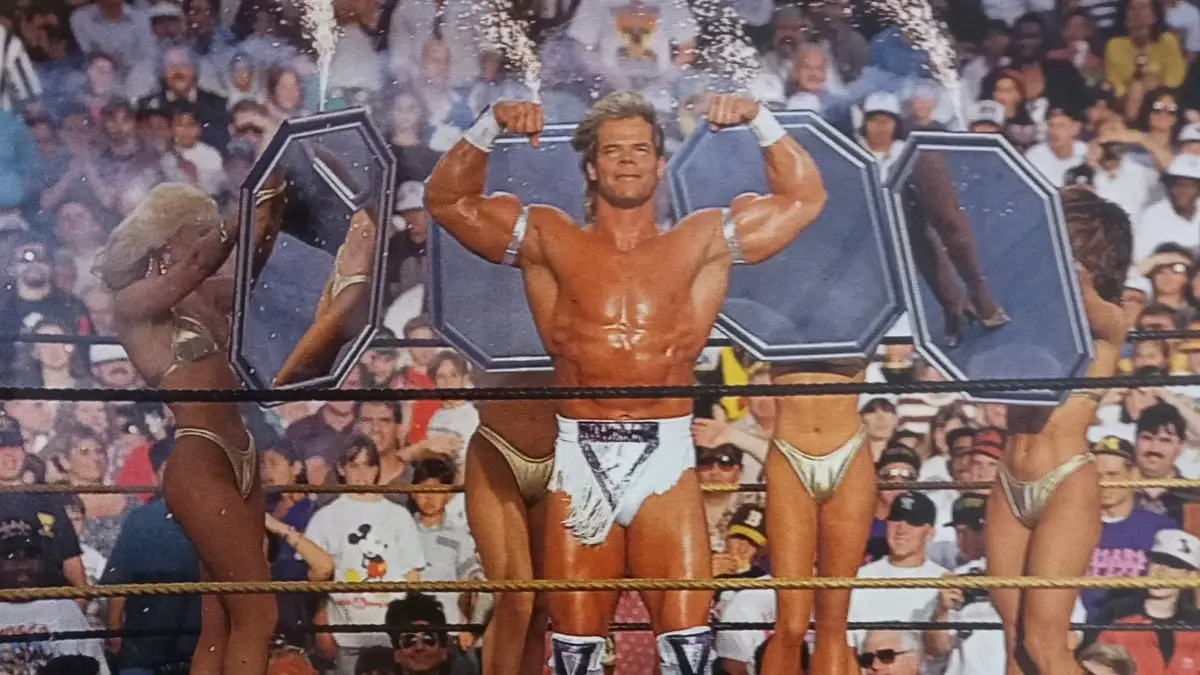
Luger badly needed a new paint job. Come early summer, McMahon had a redesign in mind, one with star-spangled hues.
With Hogan now persona-non-grata, McMahon staged what may as well have been a public audition for the new Hulkster, though the winner had already been determined. This "Real American Idol" took place on the deck of the USS Intrepid in New York City, on the Fourth of July 1993. And its opening act called for many capable athletes to fail in succession.
The premise was that reigning WWE Champion Yokozuna challenged all proud Americans to try and bodyslam him onboard the Intrepid on America's birthday. Though legitimately a Samoan-American from California, the Yokozuna character was demonstrably from Japan, and he was the designated heel in the latest "America vs. evil foreign power" angle. Minor quibbles aside, Yoko's challenge opened the door for a new American hero to emerge. Wrestlers like Randy Savage, Crush, The Steiner Brothers, and Bob Backlund, as well as athletes from other sports like football and hockey, took turns failing to flip the 570-pound champion.
Finally, just as Yokozuna and Mr. Fuji were about to have the last laugh, a helicopter dramatically descended upon the battleship. There was going to be one more challenger to the evil titleholder. Naturally, the fans on hand chanted Hogan's name. Then Luger emerged from the chopper, drawing some boos.
Eventually, those boos turned to cheers when Luger, dressed in an American flag t-shirt, shoved away a presiding Bobby Heenan, then hit the ring to answer the challenge.
After cutting a somewhat dicey promo on the champ, Luger threw Fuji to the floor, avoided a Yokozuna charge, and smashed him with his surgically repaired forearm. Luger then overturned the mighty Yoko with a "good enough" bodyslam to win the challenge in the name of country.
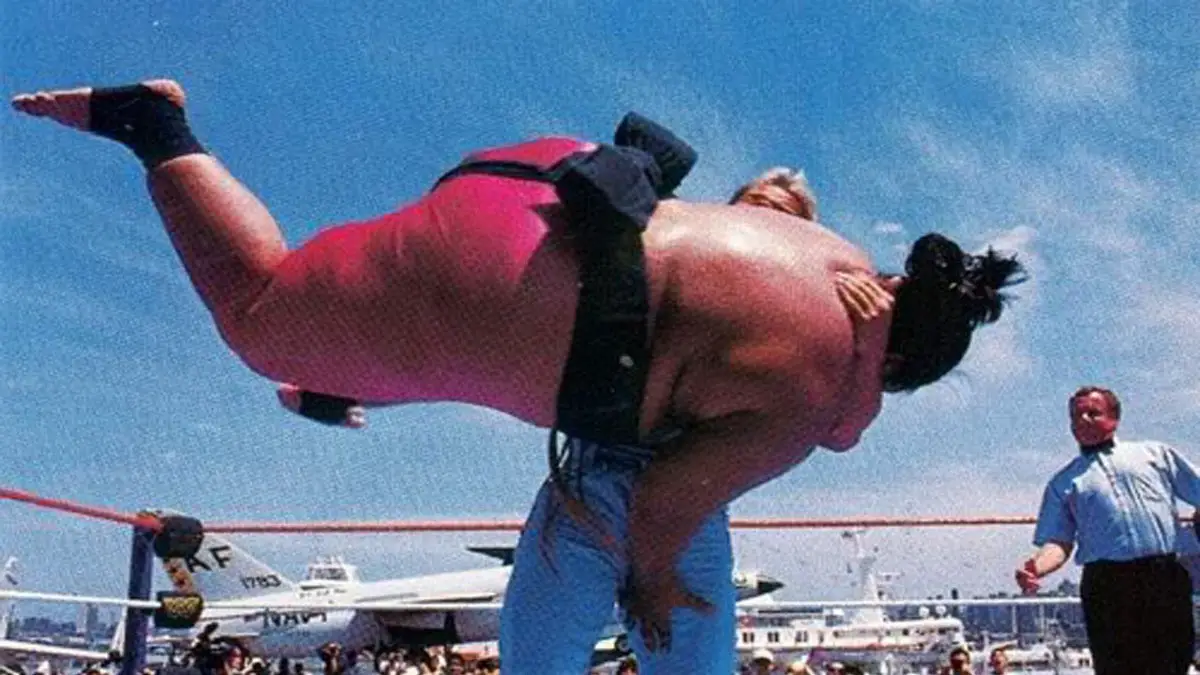
The following night on WWE Raw, clips of the public spectacle aired, with the broadcast team (especially Vince) putting on their best storyteller voices for the narration. They were actively building the Lex Luger legend, using the accelerated course to re-engineer Luger as Hogan 2.0. They needed to get Luger over quickly too, because in eight weeks time at SummerSlam, he was going to challenge Yokozuna for the WWE Championship.
Of course, this proposition wasn't guaranteed to work out. For one thing, Hogan's connection with a wide audience a decade earlier was authentic. Audiences didn't need to be told to like Hulk - they just liked Hulk, because he was an evolutionary Superstar Billy Graham with all the charisma, plus an affable nice guy energy. The magnetism between star and audience was natural.
Here, the WWE was attempting the synthetic approach, loudly suggesting Luger's greatness and strong attributes to its audience, in the hopes that they caught on. Hogan slammed many imposing giants in his day, but he didn't need Vince to rent a battleship for him to connect with the audience.
Also working against Luger was the disparity in charisma. While most wrestlers would find it onerous to match Hogan in energy and verbal skills, Lex was by no means an outgoing personality. Naturally reserved and laid back, Luger wasn't anything close to a home run on the mic - not horrendous, but not electrifying either.
Simply put, Luger didn't light up the room the way Hogan did. Getting the impressionable young WWE audience to accept him as Hulk's worthy successor was going to take some work.
So you have this muscular American superhero that's standing up to the "foreign menace" that hates America, and happens to possess the WWE Title. You need to convince the audience that this superhero is worthy of carrying the torch of the post-Hogan WWE generation, and is fit to dethrone this monster champ. What do you do?
WWE could have simply had Luger wrestle and defeat credible heels on his way to facing Yokozuna but the company instead opted to put the former WCW on a tour bus and have him tour the United States.
With that, The Lex Express was born. The Express was a giant red, white, and blue tour bus, with the words "LEX LUGER" and "LEX EXPRESS" printed on the sides, in addition to some prominent yellow WWE logos.
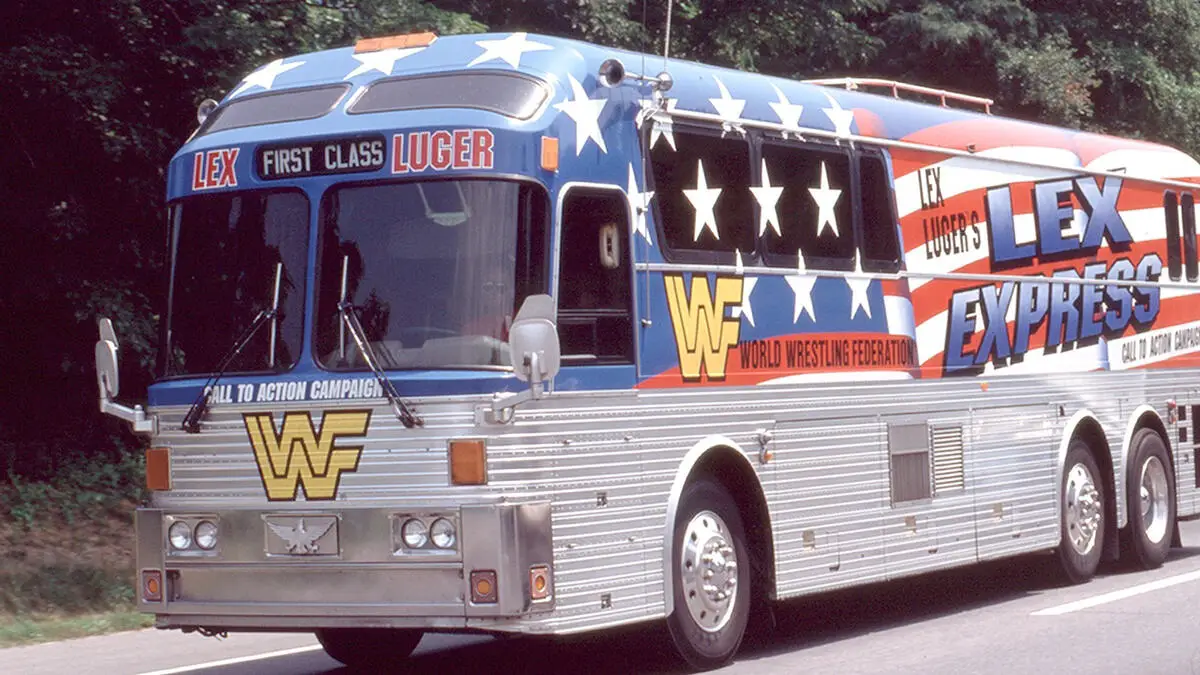
As for the purpose of the Lex Express, Luger was going to be riding on it for his "call to action" campaign. Like a politician running for office, Luger was building public support to convince WWE President Jack Tunney to grant him a shot at Yokozuna's belt.
According to Luger, the Express wasn't some flimsy character prop: he legitimately toured with this bus around the United States for upwards of 16 hours a day, over the course of six or seven weeks. While on tour, Luger made numerous media appearances, and participated in autograph sessions and photo-ops.
To Luger's credit, he was apparently quite the draw at some of these appearances. In his memoirs, Luger recalled an appearance at a Toys-R-Us in Denver, where the line of people waiting to see him, "snaked around the store twice". For another appearance at Mount Rushmore in South Dakota, Luger remembered that eager fans swarmed the Lex Express on sight, causing Lex to have to climb out via the fire escape on the bus' roof.
But it wasn't all fun times. Luger was reportedly sometimes late for scheduled appearances, due to trying to squeeze in workouts and meals. Time to himself was minimal, as while Luger might've been able to get a good night's sleep at a hotel, he was otherwise touring relentlessly.
Touring relentlessly to build his profile among people that *might* be interested in seeing him wrestle. During the sheer majority of the Lex Express' nationwide tour, Luger did not wrestle at all. After defeating Bret Hart on a July 10 house show in Seattle, and before having a practice match against Yokozuna at an August 23 USWA card in Memphis, Lex did not take part in any matches.
Instead of acclimatising their audience to Luger and giving him a solid foundation of support, WWE felt it was more important to put him on a bus and have him sign autographs at shopping malls for weeks on end. It was a curious decision to keep their theoretical next big star out of the ring entirely during that crucial stretch.
In that month-and-a-half timeframe, Luger's TV appearances were reduced to either footage from his "campaign stops", or a rather dull series of personality profiles entitled "Who is Lex Luger?". In the latter, Luger discussed his past and his personal feelings, though energy-wise he sounded like he was reading IKEA instructions out loud to a friend.
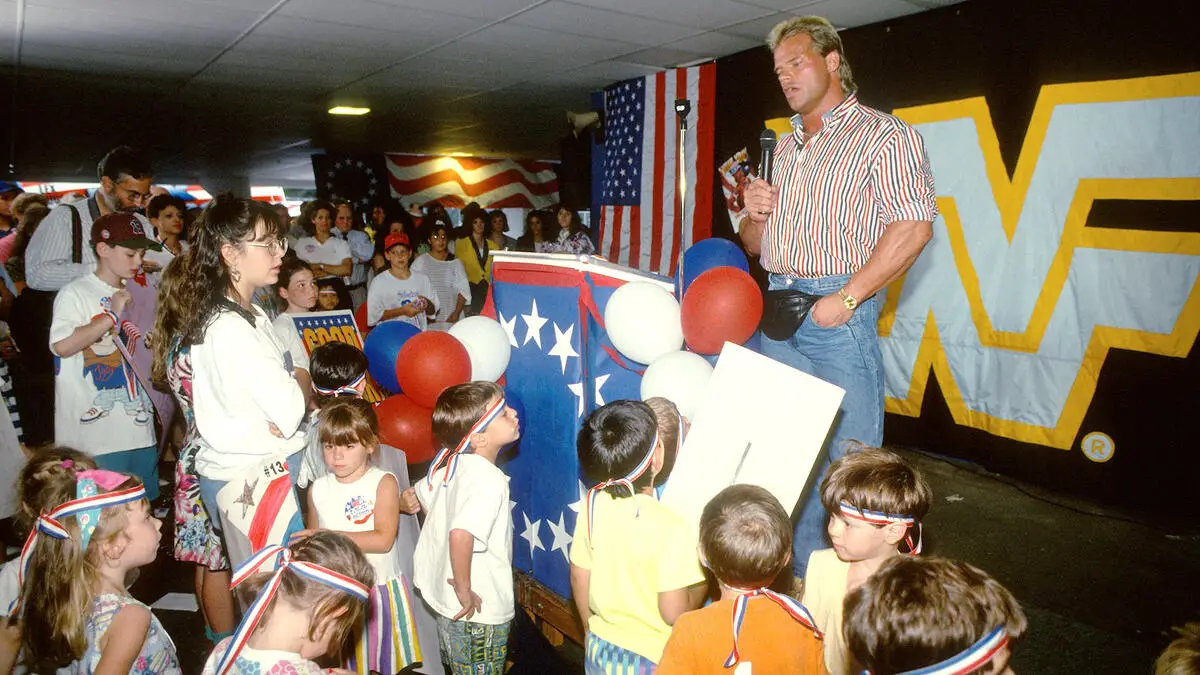
Luger did make *one* in-ring appearance during that time, and it was both good and bad.
On the episode of Monday Night Raw that aired August 9, Luger and Yokozuna were on hand for Bruce Prichard's favourite trope, the in-ring contract signing. It was here that suit-wearing Luger cut one of the more fiery promos of his career, and honestly looked like one million bucks, every bit the star that WWE was counting on him to be.
The only real problem with the segment was a stipulation that was added to the SummerSlam match. At the contract signing after Luger signed on the dotted line, Jim Cornette, who was now Yokozuna’s “American spokesman”, revealed a critical detail in the contract; SummerSlam would be Luger’s only shot at the WWE Championship.
Prevailing logic pointed to a Luger victory at SummerSlam, especially as he had been ordained as the new Hulk Hogan by Vince McMahon himself. He received a patriotic makeover, a tour bus, a nationwide "campaign trail", and even a music video that was essentially a four-minute motivational poster set to a faux-John Mellencamp ballad. Heartland, heart-strings, heart of a champion in one video.
On Monday, August 30, at the Palace of Auburn Hills, the moment of truth arrived. Luger stepped off the Lex Express one last time, and prepared to step into the history books.
The WWE Title match had more pomp and pageantry than most preceding it. Both the Japanese and American national anthems were sung, with R&B singer Aaron Neville honouring America. The set design for SummerSlam was all manner of red, white, and blue.
When Luger entered, he did so to a spirited rendition of "Stars and Stripes Forever". His attire consisted of flag-centric kneepads and trunks, the latter of which was framed by a golden waistband. No doubt that Luger, complete with his chiselled body, looked the part of a patriotic conqueror.
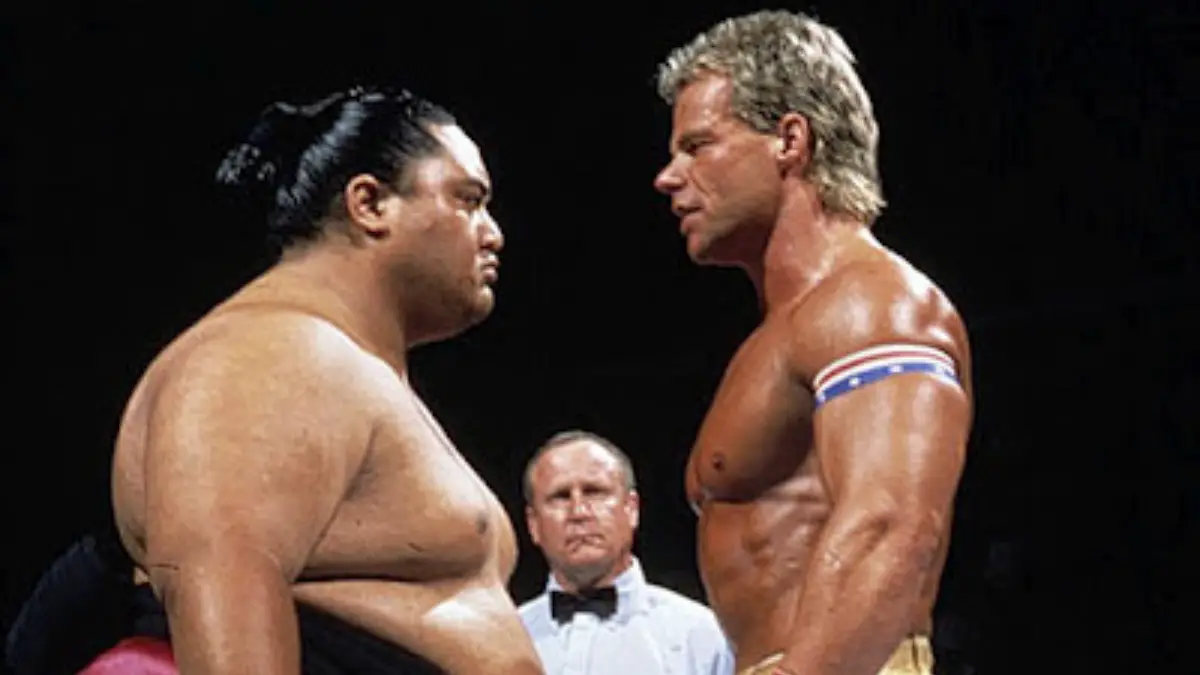
Then the match began, and it was pretty decent. Some big spots, a failed slam attempt, a long heat segment, and a gradual comeback. All the elements of a Hogan vs. monster-of-the-month showdown were evident.
Then the finishing sequence commenced. The crowd was mostly with Luger as he fought off the champion's onslaught, avoided a corner charge, and then finally slammed his monstrous foe, just as he had on the day this big push was born. The title was at last within reach. At this point, Luger removed his stars-and-stripes arm-pad, exposing his supposed reinforced forearm. Charging at the champion, Luger smashed Yokozuna in the skull with his forearm, knocking his beastly opponent through the ropes, and to the arena floor with a thud.
As Luger took time to punch an apoplectic Cornette off the apron, Earl Hebner levied the count, and, as Yoko remained motionless on the floor, counted to 10.
Lex Luger won, but by count-out and the WWE Championship, after everything, didn’t change hands. Luger had only one shot at Yokozuna and he didn’t win the belt.
At this point, Luger should've dropped to his knees in despair and openly wept. Instead, all the while phlegm-throated Vince screamed and gushed with misplaced joy on commentary, Luger was mobbed by Randy Savage, Tatanka, and The Steiners, who hoisted him up high while confetti and balloons fell, "Stars and Stripes Forever" blared, and quite a few oblivious fans cheered the whole scene on.
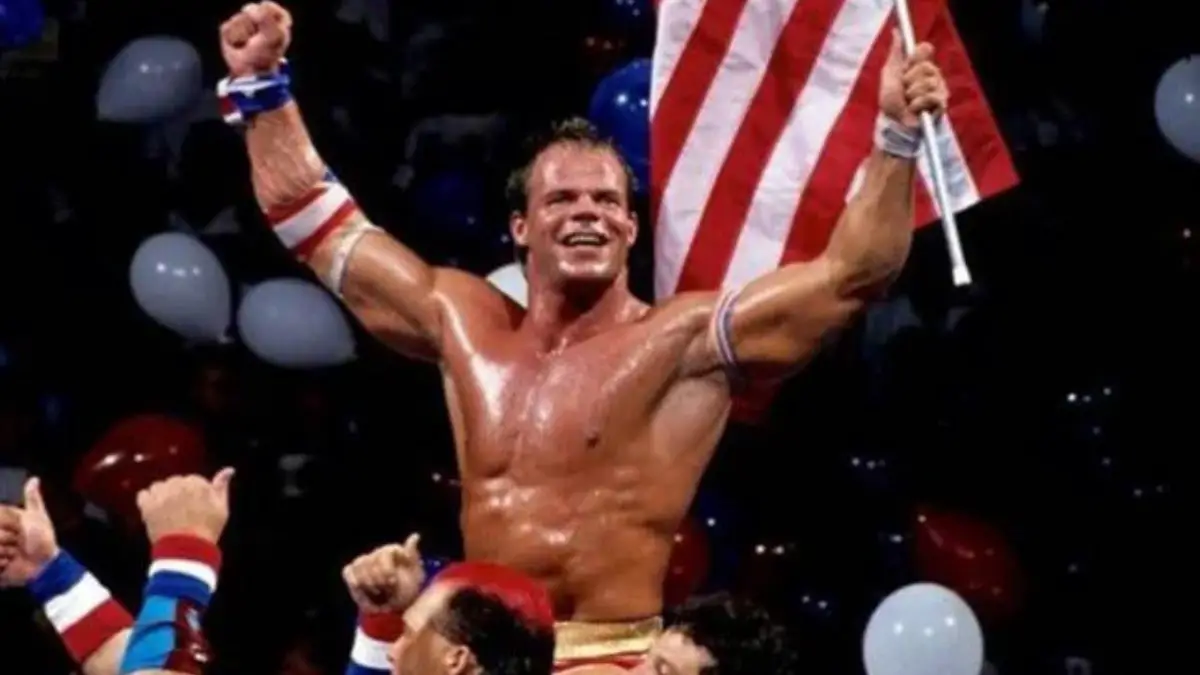
How ironic it was that, after spending two months trying to make Lex Luger the coolest, most powerful good guy possible, Vince McMahon undid it all by scripting him to look like the biggest idiot in the world.
So what happened? As most stories have it, McMahon decided weeks earlier that he wasn't going to switch the belt at SummerSlam, wanting to instead hold off until the following year's WrestleMania to coronate Luger.
That was all well and good, but there was just one problem: that big stipulation that Jim Cornette announced ahead of SummerSlam. In WWE’s eyes, the workaround was that Luger would win the 1994 Royal Rumble to earn a second shot, then make good at WrestleMania 10 with a new lease on life.
There was another issue, however. In the eyes of longtime fans who watched multiple companies, Luger had long been booked as a choke artist. More than once, Luger fell short in challenges of Ric Flair for the big gold belt, even in instances where it felt like Luger winning was the only logical outcome. And when Luger finally did win, he didn't even get to beat Flair, because Jim Herd fired 'The Nature Boy' two weeks before Lex got that elusive victory.
Even when Lex *won*, he lost. SummerSlam was merely Exhibit B. For fans that didn't watch WCW, they just watched Luger fail in a way that Hogan never, ever failed. Plus, the Royal Rumble was five months away - that's five more months of Yokozuna being champion, five more months of Luger not having an available second chance, and five more months for the audience to remind themselves of how moronic Luger looked at SummerSlam by celebrating the count-out win.
Over the months ahead, Luger pushed through a dreadful feud with Finnish environmentalist Ludvig Borga, before entering that '94 Rumble. By then, Luger's momentum had stalled the way a poorly-maintained bus might stall.
Luger ended up co-winning the Rumble, after he and Bret Hart went over the top at the same time. The idea was to announce each man separately as the winner, and judge the crowd reactions to each announcement, thus letting the spectators in Providence, Rhode Island reveal who the choice of the people was.
Luger was announced as winner first, drawing a mixed reaction that was maybe 65 percent cheers, at best. Then the other referee said that Bret won, which drew a much more enormous scream.
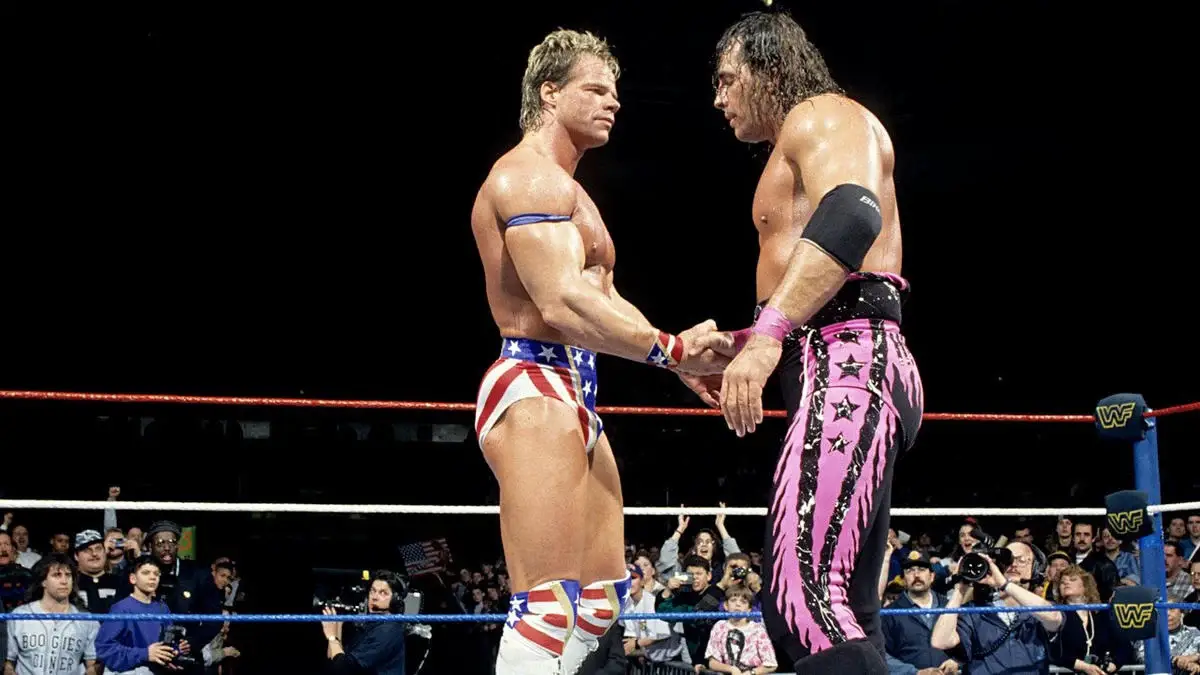
Luger's fate was sealed. At WrestleMania 10, an elaborate two-match series was set up, wherein Luger lost to Yokozuna via disqualification in the middle of the card, before Bret won the belt from Yoko in the main event.
Luger was one of the individuals who hoisted up a triumphant Hitman at the end of the night. Lex would never again challenge for the WWE Championship.
Seven months earlier, Lex Luger was the chosen one, the hand-picked flagbearer (literally, he sometimes toted "Old Glory") of the WWE’s next era. The closing of Hogan's book begat the opening of Luger's, and with it, a road was immediately paved for him to win the top belt, and then lead the way from there.
Instead of doing things the easy way, Vince McMahon chose to play the long game. By doing things the way he did, Vince threw out a summer's worth of unremitting hype, booked the new hero to fall short, and thought he could work around a storyline roadblock that he himself booked into existence.
Instead, Luger's count-out win took the air out of those red, white, and blue balloons. That one-shot stipulation and the sight of Luger merrily celebrating his pyrrhic victory destroyed everyone's faith in one fell swoop.
Most symbolic of Luger's scripted failure is The Lex Express, the well-adorned tour bus that Lex spent the summer of 1993 on, as he endlessly criss-crossed the map. In receiving a world title-calibre push, no wrestler before or since had ever had their own company-issued tour bus, nor had their mode of transportation hyped up as frequently on television as The Lex Express was.
Decades later, the handling of the SummerSlam main event remains one of the most confounding and ridiculed booking decisions in wrestling history. When the Lex Express went off the road, all that was left for WWE to do with the bus was throw their hero under it.
